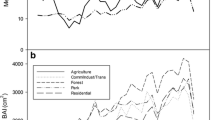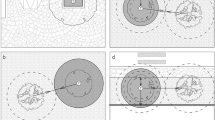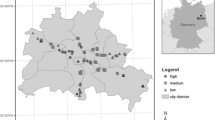Abstract
Urban stresses are known to affect street trees growing in spatially restricted conditions, but even in relatively large parks the cumulative effects by construction, pedestrian uses, and impacts from temporary events may have deleterious long-term effects on plant health. In Columbus, Ohio, the 93 ac (42.3 ha) Franklin Park has been subjected to major construction events and site re-configuration about once per generation—at least six times in 150 years. The first recorded shade- and ornamental tree installations occurred between 1895 and 1910. Those trees, as well as those native to the park, were mapped in 1939, 1989, and again in 2000. Testing the hypothesis that cumulative disturbance reduces tree vigor and growth rate even in open-grown conditions, tree diameters were compared over the sixty year period between 1939 and 2000. Soil compaction and percolation were measured on a 50 m grid, and maps were overlain to determine where site disturbance,buildings, utility lines, paths and pavements had occurred since 1860. Only 8% of the park's surface escaped disturbance; undisturbed areas occurred only in isolated patches. For all trees, trunk diameter increase averaged 0.5 cm/year for 61 years. While late successional species (e.g., Quercus, Acer) had growth rates less than expected for open-grown specimens, many early successional species (Celtis, Populus) were less affected. Despite availability of soil nutrients and lack of canopy or understory competition, tree health was generally poor in all size classes and the majority of the trees present in 1939 were in decline by 2000.
Similar content being viewed by others
References
Burns, R.M. and Honkala, B.H. (1990) Silvics of North America, Vols. I and II. USDA Forest Service, Agriculture Handbook #654, Washington, DC.
Clark, J.R., Matheny, N.P., Cross, G. and Wake, V. (1997) A model of urban forest sustainability. J. Arboriculture 23, 17–30.
Clark, J.R. and Matheny, N.P. (1998) A model of urban forest sustainability: application to cities in the United States. J. Arboriculture 24, 112–120.
Dawson, J.O. and Khawaja, M.A. (1985) Change in street-tree composition of two Urbana, Illinois, neighborhoods after fifty years: 1932-1982. J. Arboriculture 11, 344–348.
Dorney, J.R., Guntenspergen, G.R., Keough, J.R. and Stearns, F. (1984) Composition and structure of an urban woody plant community. Urban Ecol. 8, 69–90.
Dow, K. 2002. Social dimensions of gradients in urban ecosystem. Urban Ecosys. 4, 255–275.
Dupouey, J.L., Dambrine, E., Lafitte, J.D. and Moares, C. (2002) Irreversible impact of past land use on forest soils and biodiversity. Ecology 83, 2978–2984.
Effland, W.R. and Pouyat, R.V. (1997) The genesis, classification, and mapping of soils in urban areas. Urban Ecosys. 1, 217–228.
Fostad, O. and Pedersen, P.A. (1997) Vitality, variation, and causes of decline of trees in Oslo Center (Norway). J. Arboriculture 23, 155–165.
Gilman, E.F. (1990) Tree root growth and development. II. Response to culture, management and planting.J.Env. Hort. 8, 220–227.
Gilman, E.F., Leone, I.A. and Flower, F.B. (1987) Effect of soil compaction and oxygen content on vertical and horizontal root distribution. J. Env. Hort. 5, 33–36.
Hopkins, R.M. and Patrick, W.H. (1964) Combined effect of oxygen content and soil compaction on root penetration. Soil Sci. 108, 408–413.
Houde, J. (1997) Public property tree preservation. J. Arboriculture 23, 83–86.
International Society of Arboriculture (eds.) (1992) Tree Appraisal Guide. Prepared under contract by the Council of Tree and Landscape Appraisers, Savoy, IL.
Konijnendijk, C.C. (1997) A short history of urban forestry in Europe. J. Arboriculture 23, 31–39.
Loeb, R.E. (1989) The ecological history of an urban park. J. Forest Hist. 134–142.
Nicolosi, R.T. and Fretz, T.A. (1980) Evaluation of root growth in varying medium densities and through dissimilar soil surfaces. HortScience 15, 642–644.
Nowak, D.J. (1994) Understanding the structure. J. Forestry. 92(10), 42–46.
Patterson, J.C. (1977) Soil compaction and its effects upon urban vegetation. J. Arboriculture 3, 161–167.
Poracsky, J. and Scott, M. (1999) Industrial-area street trees in Portland, Oregon. J. Arboriculture 25, 9–17.
Pickett, S.T.A., Cadenasso, M.L., Grove, J.M., Nilon, C.H., Pouyat, R.V., Zipperer, W.C. and Costanza, R. (2001) Urban ecological systems: linking terrestrial ecological, physical, and socioeconomic components of metropolitan areas. Ann. Rev. Ecol. Syst. 32, 127–157.
Quigley, M.F. (1979). Photoperiodic response to street lighting. Land. Architecture 79, 504–514.
Quigley, M.F. and Platt, W.J. (2003) Composition and structure of seasonally deciduous forests in the Americas. Ecol. Monographs 73, 79–98.
Randrup, T.B. (1997) Soil compaction on construction sites. J. Arboriculture 23, 207–210.
Rudnicky, J.L. and McDonnell, M.J. (1989) Forty-eight years of canopy change in a hardwood-hemlock forest in New York City. Bull. Torr. Bot. Club 116, 52–64.
Soil Conservation Service (1991) Soil Survey of Franklin County, Ohio. United States Department of Agriculture, in cooperation with Ohio Department of Natural Resources, Division of Lands and Soil, and Ohio Agricultural Research and Development Center.
Sydnor, T.D. (1999) The response of Ohio's native and naturalized trees to construction activity. (pp. 11. Available from http://www.ag.ohio-state.edu/~natres/constr.htr)
Author information
Authors and Affiliations
Rights and permissions
About this article
Cite this article
Quigley, M.F. Franklin Park: 150 years of changing design, disturbance, and impact on tree growth. Urban Ecosystems 6, 223–235 (2002). https://doi.org/10.1023/A:1026157629609
Issue Date:
DOI: https://doi.org/10.1023/A:1026157629609




